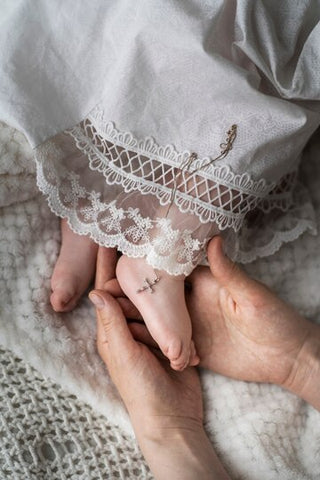The entry of a child into this world is a moment of great joy in all cultures, celebrated through many customs inscribed in the traditions of each one.
And because we want to take you through all the corners of this planet, we thought it might be interesting to learn about the different customs of welcoming the newborn around the world, offering a fascinating perspective on cultural diversity and common values.
Stay with us and get ready for a trip around the world. We will take you through distant Asia, meet a part of the Middle East and see how Latin Americans celebrate the birth of a baby. We also arrive at home, in Europe, where we discover how our close or distant neighbors are used to welcoming a baby.
Asian traditions

If we look at Chinese culture, here the essential idea is to protect both the child and the mother. When the news of the pregnancy comes out, the family says that the mother was blessed with happiness, the whole family offering her protection. After giving birth, the new mother recovers by lying in bed for a month, during which she is advised not to leave the house. Why this? Because pollution and extreme weather conditions could affect his health and general condition, environmental factors, pollution.
In this culture, it is considered that the name chosen for the child influences his future, being chosen with great care.
The first important event for the newborn is the celebration of one month after the birth, when in the morning following the 30th birthday, the parents make offerings to the gods so that they protect the child. Relatives and friends receive gifts from parents: red-dyed eggs, symbolizing the process of life change, while the round shape signifies a happy and harmonious life. I also receive food, chicken, cakes, all in even numbers.
In Japan, the first birth celebration takes place on the seventh night, when the little one receives the name in front of the family, during a feast. On this night, the father writes the name and date of birth in calligraphy on a white paper.
The mother and the baby stay for 21 days in the maternal grandparents' house. Visitors are welcome, they are served with a special dish of red beans and rice (osekihan).
When he was one month old, the family took him to a Shinto shrine for the first time. The mother's family presents the child with a type of formal dress to wear on this occasion. The visit allows the introduction between the baby and the gods. Moreover, a prayer for health and happiness is said to the baby.
At 100-120 days, the baby enjoys a meal of traditional Japanese food. Mother and father both feed the child, alternating. They also aim for the little one to be well fed in the future. For girls, the family buys a special set of black plates, while boys get a set of red plates for this occasion.
European traditions

In the Czech Republic , an atypical custom of welcoming the little one is tying colored diapers to the branches of a tree in front of the parents' house. A habit that symbolizes joy and abundance.
In Germany, you wouldn't believe that parents are obliged to follow a list of names approved by the government. If they still choose a name that does not exist on that list, they must present convincing arguments for the state to make an exception.
How is the newborn welcomed in the famous "boot" of Europe? Pink or blue ribbons are hung on the houses depending on the gender of the child.
But in Spain? The babies are dressed in clothes colored with red, which is supposed to ward off evil. A very strange custom is practiced in Castrillo de Murcia, also in Spain, where men dress up in devil costumes and jump over a mattress on which newborns are laid, a custom practiced since the 60s. The goal is to protect them from diseases, from evil in general.
How do the French welcome a new born baby? With Sophie. It is the giraffe that squeaks, being a popular gift among this people.
What about the Russians? The father gives the nurse an envelope of money for helping to deliver the baby. It's a modest amount, don't think about something exorbitant. It is practiced as a symbolic gesture of gratitude, which should bring happiness and well-being to the little one.
Did you know that in Austria, those who attended the wedding of a child's parents return with fresh food even after the child's birth? It is a ritual called "Weisat".
Customs from the Middle East

I arrived in the Arab world, where solid relationships within a family are known throughout the world. Similar to Chinese and Japanese culture, the mother's family in this world provides her with significant support. It is interesting that future mothers who live in another part of the world return home to give birth in their native place, but especially to be surrounded by family.
The baby is greeted with a phrase "mabrouk ma'a ajakemwhich" which means "congratulations on what you have received."
Another Islamic ritual is performed by the father or the paternal grandfather and consists in whispering the Athan (call to prayer) in the right ear of the child and the Iqama (second call) in the left ear.
After the birth, the child's father gives the new mother a gold piece of jewelry, while the rest of the family invests money in the baby's clothes.
On the seventh day after the birth, an animal is sacrificed if it is a girl, and 2 animals if it is a boy, the sacrifice is followed by a real feast in the family, and the meat is also distributed to those in need.
Another important Islamic ritual that usually takes place immediately after the birth of a boy is circumcision, known as Tuhoor. This procedure is believed to reduce the risk of infection.
Latin American customs

In the Latin American region, mothers recover 40 days after labor, during which time they refrain from intimate relationships with their partners, physical activity and spicy foods. The other members of the family help the mother with household chores, so that it will be easier for her to recover.
This period is called quarantine, during which cold showers and hot soups are avoided.
A custom is to dress the child in red clothes for the same reason, to ward off evil spirits. In Brazil, this tradition is especially practiced, assuming that it brings luck and happiness.
Sure, there may be regions where these customs are not respected by mothers, but they exist and define the beginning of a baby's life in any culture.
In the end...
We explored the traditions of welcoming the new born from all over the world and discovered that, despite the diversity, love and joy remain the fundamental values in any culture.
What other traditions do you know? Share with us in a comment and enrich our culture.
Info sources:
https://www.thoughtco.com/chinese-birthday-customs-for-newborns-4080790
https://welcome2jordan.com/birth-rituals-middle-east/
https://www.ucbaby.ca/baby-birth-traditions-brazil
https://www.thebump.com/a/birth-traditions-around-the-world
https://coursefinders.com/blog/en/25155/baby-customs-and-traditions-around-birth



